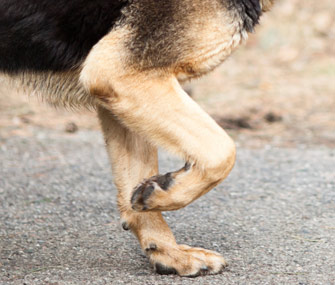Is Your Dog a Candidate for Elbow Replacement?
Published on December 17, 2013
Skip To

The Bionic Dog. It has a ring to it, doesn’t it? And it’s not just the plot of a television show: Total hip replacements have been available to dogs for more than 35 years, and now they can also get new elbow joints. My Idaho friend and colleague Dr. Randy Acker helped develop the cutting-edge technology, which was first introduced in 2008. It’s a real advance for dogs in pain from elbow dysplasia who haven’t been helped by arthroscopic surgery, pain medication, physical rehab or nutraceuticals such as glucosamine-chondroitin supplements.
What Is Elbow Dysplasia?
The elbow is a complex joint. It’s basically a hinge, but one with a twist: it can rotate about its long axis. A dog’s elbow joint gets much more of a workout than a person’s because the front legs bear about 60 percent of a dog’s body weight. When a dog’s elbow isn’t formed correctly, the result is a condition called elbow dysplasia. It’s seen most often in large and giant breeds.The term elbow dysplasia is used to describe several different conditions: ununited anconeal process (UAP), osteochondritis dissecans (OCD) and fragmented medial coronoid process (FMCP). In UAP and FMCP, the bones of the elbow joint don’t fit together well and place abnormal pressure on the foreleg bone, or ulna.
The most common form elbow dysplasia takes is FMCP. It occurs when a little piece of bone called the coronoid process breaks off from the ulna, causing pain and swelling. We see it most often in young male Labrador Retrievers, Newfoundlands, German Shepherd Dogs and Rottweilers.
With UAP, the anconeal process, a small piece of bone that sticks out from the ulna, fails to attach to it or breaks off from it. The cartilage — tough, flexible connective tissue that protects bones by preventing them from rubbing against each other — becomes swollen and painful and is eventually destroyed.
In OCD, the bone that supports the cartilage within the elbow joint (or other joints) matures improperly. The cartilage thickens and cracks, exposing the underlying bone and causing swelling and pain.
For all of these conditions, the eventual result is painful and crippling chronic osteoarthritis, often at a young age. Dogs with elbow dysplasia may tire quickly from activity, spend a lot of time lying down, and limp or be unwilling to walk even short distances. A physical exam that includes palpating the elbow joint, plus radiographs and sometimes a CT scan or arthroscopy — a minimally invasive procedure that allows the veterinarian to see inside the joint and even make repairs — can diagnose the problem.
If your dog has FMCP or OCD, arthroscopic surgery is usually the best way to proceed. Removing the broken fragment or damaged cartilage usually improves the condition. Sometimes elbow dysplasia can be managed medically with weight loss, limiting the dog’s activity, pain medication, shockwave therapy, and nutraceuticals such as glucosamine and chondroitin to help protect and rebuild cartilage.
When should you consider elbow replacement? Ask about it if arthritis is severe and the condition can’t be managed effectively with the above methods. The procedure has been performed in more than 200 young and middle-aged dogs with good results.
What You Should Know
Before surgery, your dog must be screened to make sure the wrist and shoulder of the affected leg are in good condition and that he doesn’t have any other medical conditions that could make surgery risky. He may need to lose weight before undergoing surgery.The surgery is complex. It involves performing a CT scan with 3D reconstruction of the elbow, which is then converted to a movie that spins the 3D model continuously on a computer screen so the surgeons can refer to it as they work. The surgery takes two to three hours to complete.
Not every veterinarian is trained in the technique. You will likely have to find a specialist who has performed it. This may require traveling some distance.
Your dog will need to be hospitalized for several days following surgery. Once he’s home, he will probably sleep a lot for the first week, or at least not want to do much of anything.
Results aren’t immediate. Lameness begins to improve about 12 weeks after surgery and continues to improve for approximately six months. It will be at least that long before your dog is back to normal. He may not be willing to use the repaired leg for the first couple of months, and off-leash activity may be prohibited for some time.
The procedure is expensive. Expect to spend $5,000 to $6,000. Pet health insurance may or may not cover the cost. Some policies do not cover genetic conditions. If the surgery is done at a veterinary school or specialty clinic where surgeons are being trained in the technique, you may get a break on the cost. It can’t hurt to ask.
Once they recover, dogs display a noticeable difference in attitude and movement, but if the other elbow is also affected, they may still need rehab in the form of swimming or underwater treadmill work, acupuncture, pain medication, or a special diet designed to aid joint mobility. Some dogs have both elbows replaced, but only one can be done at a time.

